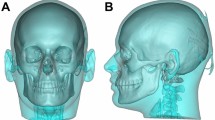Abstract
Maxillofacial surgery simulation and planning is an extremely challenging area of research combining medical imagery, computer graphics and mathematical modelling. In maxillofacial surgery abnormalities of the skeleton of the head are treat by skull remodelling. Since the human face plays a key role in interpersonal relationships, people are very sensitive to changes to their outlook. Therefore planning of the operation and reliable prediction of the facial changes are very important. Recently, the use of 3D image-based surgery planning systems is more and more accepted in this field. Although the bone-related planning concepts and methods are maturing, prediction of soft tissue deformation needs further fundamental research. In this paper we present a soft tissue simulator that uses a fast tetrahedral mass spring system to calculate soft tissue deformation due to bone displacement in a short time interval. Results of soft tissue simulation for patients who had a maxillofacial surgery are shown. Finally we truly validated the simulation results and compared our method with others.
Chapter PDF
Similar content being viewed by others
Keywords
These keywords were added by machine and not by the authors. This process is experimental and the keywords may be updated as the learning algorithm improves.
References
Gladilin, E., Zachow, S., Deuflhard, P., Hege, H.: Towards a realistic simulation of individual facial mimincs. In: SPIE Medical Imaging Conference (2002)
Schutyser, F., Cleynenbreugel, J.V., Ferrant, M., Schoenaers, J., Suetens, P.: Image based 3d planning for maxillofacial distraction procedures including soft tissue implications. In: Delp, S.L., DiGoia, A.M., Jaramaz, B. (eds.) MICCAI 2000. LNCS, vol. 1935, pp. 999–1007. Springer, Heidelberg (2000)
Muller, M.: Stable real-time deformations. In: ACM SIGGRAPH Symposium on Computer Animation (SCA) (2002)
Teschner, M.: Direct Computation of Soft-Tissue Deformation in Craniofacial Surgery Simulation. PhD thesis, Friedrich-Alexander-Universitat (2000)
Bourguignon, D., Cani, M.P.: Controlling anisotropy in mass-spring systems. In: The 11th Eurographics Workshop on Animation and Simulation (2000)
Mollemans, W., Schutyse, F., Cleynenbreugel, J.V., Suetens, P.: Tetrahedral mass sping model for fast soft tissue deformation. In: Ayache, N., Delingette, H. (eds.) IS4TM 2003. LNCS, vol. 2673, pp. 145–154. Springer, Heidelberg (2003)
Poukens, J., Schutyser, F., Cleynenbreugel, J.V., Riediger, D.: 3d planning of distraction osteogenesis with maxilim software. In: Proceedings 4th international congres of maxillofacial and craniofacial distraction, pp. 251–254 (2003)
Maes, F., Collignon, A., Vandermeulen, D., Marchal, G., Suetens, P.: Multimodality image registration by maximization of mutual information. IEEE transaction on Medical Imaging 16, 187–198 (1997)
Groeve, P.D., Schutyser, F., Cleynenbreugel, J.V., Suetens, P.: Registration of 3D photographs with spiral CT images for soft tissue simulation in maxillofacial surgery. In: Niessen, W.J., Viergever, M.A. (eds.) MICCAI 2001. LNCS, vol. 2208, pp. 991–996. Springer, Heidelberg (2001)
Author information
Authors and Affiliations
Editor information
Editors and Affiliations
Rights and permissions
Copyright information
© 2004 Springer-Verlag Berlin Heidelberg
About this paper
Cite this paper
Mollemans, W., Schutyser, F., Van Cleynenbreugel, J., Suetens, P. (2004). Fast Soft Tissue Deformation with Tetrahedral Mass Spring Model for Maxillofacial Surgery Planning Systems. In: Barillot, C., Haynor, D.R., Hellier, P. (eds) Medical Image Computing and Computer-Assisted Intervention – MICCAI 2004. MICCAI 2004. Lecture Notes in Computer Science, vol 3217. Springer, Berlin, Heidelberg. https://doi.org/10.1007/978-3-540-30136-3_46
Download citation
DOI: https://doi.org/10.1007/978-3-540-30136-3_46
Publisher Name: Springer, Berlin, Heidelberg
Print ISBN: 978-3-540-22977-3
Online ISBN: 978-3-540-30136-3
eBook Packages: Springer Book Archive




